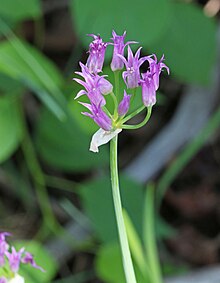RIPK3
RIPK3수용체 상호작용 세린/스레오닌-단백질 키나아제 3은 인간에서 RIPK3 유전자에 의해 암호화된 효소다.[5][6][7][8]
이 유전자의 산물은 세린/트레오닌 단백질 키나제스의 수용체 상호작용 단백질(RIP) 계열의 구성원으로, 다른 RIP 계열 구성원과 차별화된 C-단자 도메인을 함유하고 있다.암호화된 단백질은 주로 세포질에 국부화되어 있으며, 새로운 핵 국산화 및 수출 신호에 따라 핵세포질 폐쇄를 겪을 수 있다.종양 괴사인자(TNF) 수용체-I 신호 복합체의 성분으로 괴사체라고 불리는 단백질 복합체에서 RIPK1, MLKL과 상호작용해 괴사를 유발할 수 있다.[7]
상호작용
RIPK3는 RIPK1과 상호작용하여 아밀로이드 척추를 형성하는 것으로 밝혀졌다.
참조
- ^ a b c ENSG00000285379 GRCh38: 앙상블 릴리스 89: ENSG00000129465, ENSG00000285379 - 앙상블, 2017년 5월
- ^ a b c GRCm38: 앙상블 릴리스 89: ENSMUSG000000221 - 앙상블, 2017년 5월
- ^ "Human PubMed Reference:". National Center for Biotechnology Information, U.S. National Library of Medicine.
- ^ "Mouse PubMed Reference:". National Center for Biotechnology Information, U.S. National Library of Medicine.
- ^ a b Yu PW, Huang BC, Shen M, Quast J, Chan E, Xu X, Nolan GP, Payan DG, Luo Y (Jun 1999). "Identification of RIP3, a RIP-like kinase that activates apoptosis and NFkappaB". Curr Biol. 9 (10): 539–42. doi:10.1016/S0960-9822(99)80239-5. PMID 10339433.
- ^ Sun X, Lee J, Navas T, Baldwin DT, Stewart TA, Dixit VM (Jul 1999). "RIP3, a novel apoptosis-inducing kinase". J Biol Chem. 274 (24): 16871–5. doi:10.1074/jbc.274.24.16871. PMID 10358032.
- ^ a b "Entrez Gene: RIPK3 receptor-interacting serine-threonine kinase 3".
- ^ a b Li J, McQuade T, Siemer AB, Napetschnig J, Moriwaki K, Hsiao YS, Damko E, Moquin D, Walz T, McDermott A, Chan FK, Wu H (2012). "The RIP1/RIP3 necrosome forms a functional amyloid signaling complex required for programmed necrosis". Cell. 150 (2): 339–50. doi:10.1016/j.cell.2012.06.019. PMC 3664196. PMID 22817896.
추가 읽기
- Kasof GM, Prosser JC, Liu D, et al. (2000). "The RIP-like kinase, RIP3, induces apoptosis and NF-kappaB nuclear translocation and localizes to mitochondria". FEBS Lett. 473 (3): 285–91. doi:10.1016/S0014-5793(00)01473-3. PMID 10818227.
- Sun X, Yin J, Starovasnik MA, et al. (2002). "Identification of a novel homotypic interaction motif required for the phosphorylation of receptor-interacting protein (RIP) by RIP3". J. Biol. Chem. 277 (11): 9505–11. doi:10.1074/jbc.M109488200. PMID 11734559.
- Strausberg RL, Feingold EA, Grouse LH, et al. (2003). "Generation and initial analysis of more than 15,000 full-length human and mouse cDNA sequences". Proc. Natl. Acad. Sci. U.S.A. 99 (26): 16899–903. doi:10.1073/pnas.242603899. PMC 139241. PMID 12477932.
- Bouwmeester T, Bauch A, Ruffner H, et al. (2004). "A physical and functional map of the human TNF-alPha/NF-kappa B signal transduction pathway". Nat. Cell Biol. 6 (2): 97–105. doi:10.1038/ncb1086. PMID 14743216. S2CID 11683986.
- Meylan E, Burns K, Hofmann K, et al. (2004). "RIP1 is an essential mediator of Toll-like receptor 3-induced NF-kappa B activation". Nat. Immunol. 5 (5): 503–7. doi:10.1038/ni1061. PMID 15064760. S2CID 12570157.
- Yang Y, Ma J, Chen Y, Wu M (2004). "Nucleocytoplasmic shuttling of receptor-interacting protein 3 (RIP3): identification of novel nuclear export and import signals in RIP3". J. Biol. Chem. 279 (37): 38820–9. doi:10.1074/jbc.M401663200. PMID 15208320.
- Yang Y, Hu W, Feng S, et al. (2005). "RIP3 beta and RIP3 gamma, two novel splice variants of receptor-interacting protein 3 (RIP3), downregulate RIP3-induced apoptosis". Biochem. Biophys. Res. Commun. 332 (1): 181–7. doi:10.1016/j.bbrc.2005.04.114. PMID 15896315.
- Kimura K, Wakamatsu A, Suzuki Y, et al. (2006). "Diversification of transcriptional modulation: large-scale identification and characterization of putative alternative promoters of human genes". Genome Res. 16 (1): 55–65. doi:10.1101/gr.4039406. PMC 1356129. PMID 16344560.
- Zhao L, Wang G, Lu D, et al. (2006). "Homocysteine, hRIP3 and congenital cardiovascular malformations". Anat. Embryol. 211 (3): 203–12. doi:10.1007/s00429-005-0074-9. PMID 16429275. S2CID 7176317.
- Feng S, Ma L, Yang Y, Wu M (2006). "Truncated RIP3 (tRIP3) acts upstream of FADD to induce apoptosis in the human hepatocellular carcinoma cell line QGY-7703". Biochem. Biophys. Res. Commun. 347 (3): 558–65. doi:10.1016/j.bbrc.2006.06.118. PMID 16844082.
- Ahn KS, Sethi G, Krishnan K, Aggarwal BB (2007). "Gamma-tocotrienol inhibits nuclear factor-kappaB signaling pathway through inhibition of receptor-interacting protein and TAK1 leading to suppression of antiapoptotic gene products and potentiation of apoptosis". J. Biol. Chem. 282 (1): 809–20. doi:10.1074/jbc.M610028200. PMID 17114179.






